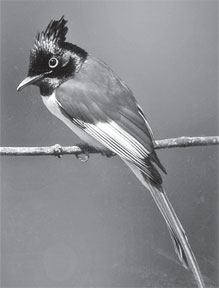The Paradise Flycatcher, a regular visitor to Sri Lanka
by K.G.H. Munidasa
 The
majority of local bird-lovers will have seen the Ceylon Paradise
Flycatcher Gini Hora or Sivuru Hora, though among them a very few may
have seen its Indian counterpart, popularly known as Kiri Hora or
Sudu-Redhi Hora, and of the two the latter is the more striking. The
majority of local bird-lovers will have seen the Ceylon Paradise
Flycatcher Gini Hora or Sivuru Hora, though among them a very few may
have seen its Indian counterpart, popularly known as Kiri Hora or
Sudu-Redhi Hora, and of the two the latter is the more striking.
There should not be any difficulty in identifying them separately,
because one is chestnut in colour, while the other pure white.
The Paradise Flycatcher, related to Babblers, Warblers and Thrushes.
falls into the sub-family Muscicapidae (flycatchers), which is
represented in Sri Lanka by nine forms, and out of them six are
residents and the rest migrants during the winter months.
Winter months
The Indian Paradise Flycatcher Terpsiphone paradisi paradisi is a
regular visitor to all climatic zones in the island during the winter
months (October to March). The Ceylon Paradise Flycatcher (Terpsiphone
paradisi ceylonensis is the residents race which breeds in the
low-Country Dry Zone and Hill Zone, and visits the Wet Zone in the
non-breeding period.
A legend current among the rural folks in India has it that their
resident race (paradisi) in adult stage drops its chestnut colouration
and assumes a white plumage. Among our villagers too, there is a belief
that the White Paradise Flycatcher (Kiri-Hora) is a resident bird which
annually sheds its long tail and goes into hiding in the heart of the
jungle until a new tail grows.
Anybody, who is looking at a White Paradise Flycatcher for the first
time is likly to take for granted it was born like that.
The fact is that irrespective of sex young of both the Indian and
Lankan races are generally chestnut in colour with blue-black heads and
whitish underparts.
After the first annual moult, the central tail feathers in the male
begin to lengthen and grows to a length of 12 to 15 inches with the
second moult.
Plumage
In the third annual moult the male of the Indian race gradually
changes from chestnut to white plumage, and by the fourth annual moult
it becomes completely while, except the head, neck and crest which
remain glossy blue-black.
The male of the Lankan race and females of both races continue in the
chestnut plumage throughout their life.
However, the females do not carry long tail streamers like the males.
The male of the Ceylon Paradise Flycatcher may sometime sport tail
streamers. For example, at Muwangala in the Gal Oya Valley in 1965 I
came upon a male with an abnormally long tail of which one strand was
pure white and the other chestnut.
In the Kelani Valley I observed a female with scapulars and a single
greater covert on the left wing white. Similarly, bi-coloured
individuals have been recorded from a number of places in the island,
over the years.
Migrating season
In a footnote to the monthly notes of the Ceylon Bird Club, Secretary
Roy Mc Leod Cameron once said stated that the reason for the assumption
of bi-coloured flycatchers as migrants was, of course, due to such
individuals having been observed during the migrating season, as were
the white ones.
He had never seen or heard of a male White Paradise Flycatcher having
been seen here during the period from May to September.
In a letter to the Ceylon Bird Club in February, 1972 world-renowned
ornithologist Major W.W.A. Phillips had expressed his view thus, "The
Ceylon Paradise Flycatcher never assumes the white phase; that is one of
the main characteristics of the Ceylon race that distinguishes it from
the Indian race.
The birds in intermediate phase are undoubtedly males of the Indian
race moulting into the fully adult stage".
Indian region
The Indian Paradise Flycatcher is found in Turkestan, Afghanistan and
Baluchistan throughout the greater part of India to Myanmar and still
father eastwards.
Three forms are described from the Indian region, out of which the
typical race paradisi occurs in the hills and dales of peninsula India
and visits Sri Lanka, during the North-east monsoon.
The race leucogaster which differs from the first mentioned in size
and details of coloration, inhabits Afghanistan, Turkestan, Kashmir and
through the Himalayas to East Nepal. The other nicobarica which has the
head, neck and breast ashy-grey with only the cap and crest black is
found in Assam migrating to the Nicobar and Andaman Islands in winter.
The race ceylonensis is endemic to this island.
Within its breeding range the Paradise Flycatcher moves about a great
deal. Thus with different localities in India it holds different status.
In one place it is Summer Visitor", in another "Passage Migrant" and
still in another locality it is a "scares winter Visitor".
The seasonal movements is evident with Lankan race, too. For
instance, in the North -East monsoon period the Paradise Flycatchers
disperse all over the Wet and Dry Zones and the Hill Zone to a level of
at least 3,700 feet. About March to April, they begin to move out again
and concentrate in the forest tracts of the drier areas, where they pair
and breed during May to June. |

